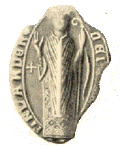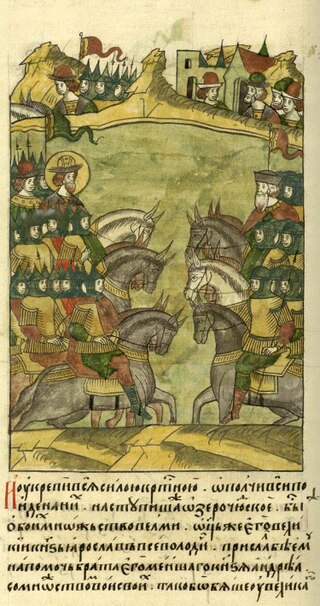
The Northern Crusades or Baltic Crusades were Christianization campaigns undertaken by Catholic Christian military orders and kingdoms, primarily against the pagan Baltic, Finnic and West Slavic peoples around the southern and eastern shores of the Baltic Sea, and also against Orthodox Christian East Slavs.

Porvoo is a city and a municipality in the Uusimaa region of Finland, situated on the southern coast about 35 kilometres (22 mi) east of the city border of Helsinki and about 50 kilometres (30 mi) from the city centre. Porvoo was one of the six medieval towns of Finland, along with Turku, Ulvila, Rauma, Naantali and Vyborg. It is first mentioned as a city in texts from the 14th century. Porvoo is the seat of the Swedish-speaking Diocese of Borgå of the Evangelical Lutheran Church of Finland. Porvoo was briefly the capital of the former Eastern Uusimaa region.

Tavastia is a historical province in the south of Finland. It borders Finland Proper, Satakunta, Ostrobothnia, Savonia and Uusimaa.
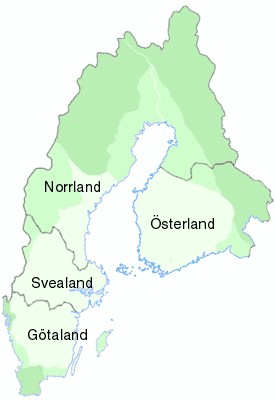
Österland (Eastland) or Österlanden (Easternlands), one of the four traditional lands of Sweden, was a medieval term used for the southern part of Finland. The term occurs in documents approximately between 1350–1470 and gradually fell out of use by the end of the 15th century. Before this period the term was used in plural, Österlanden, Easternlands.

The Swedish-speaking population of Finland is a linguistic minority in Finland. They maintain a strong identity and are seen either as a separate cultural or linguistic group or, while not regularly, as a distinct nationality. They speak Finland Swedish, which encompasses both a standard language and distinct dialects that are mutually intelligible with the dialects spoken in Sweden and, to a lesser extent, other Scandinavian languages.

The Treaty of Nöteborg, also known as the Treaty of Oreshek, is a conventional name for the peace treaty signed at Oreshek on 12 August 1323. It was the first settlement between Sweden and the Novgorod Republic regulating their border mostly in the area that is also known as Finland today. Three years later, Novgorod signed the Treaty of Novgorod with the Norwegians.
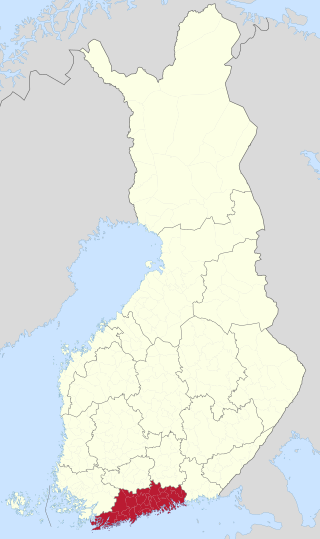
Uusimaa is a region of Finland. It borders the regions of Southwest Finland, Tavastia Proper (Kanta-Häme), Päijänne Tavastia (Päijät-Häme), and Kymenlaakso. Finland's capital and largest city, Helsinki, along with the surrounding Greater Helsinki area, are both contained in the region, and Uusimaa is Finland's most populous region. The population of Uusimaa is 1,734,000.

Johannes Thomae Bureus Agrivillensis was a Swedish polymath, antiquarian, mystic, royal librarian, poet, and tutor and adviser of King Gustavus Adolphus of Sweden. He is a well-known exponent of Gothicism.

The Raseborg Castle, is a medieval castle in Raseborg, Finland. The castle was active from 1370s to 1553. Today the ruins are open to the public in the summer and the castle is host to the yearly Raseborg Summer Theatre.
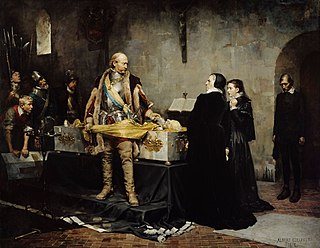
Baron Klaus Eriksson Fleming was a Finnish-born member of the Swedish nobility and admiral, who played an important role in Finnish and Swedish history during the rise of Sweden as a Great Power. He was a trustee of kings John III and Sigismund Vasa. His wife was Ebba Stenbock.

The Russo-Swedish War of 1495–1497, known in Sweden as the Stures' Russian War, was a border war which occurred between the Grand Duchy of Moscow and the Kingdom of Sweden. Although the war was relatively short, and did not lead to any territorial changes, it has significance as the first war between Sweden and Moscow. Sweden earlier fought wars against the Novgorod Republic, before Novgorod was formally annexed to Moscow in 1478.

The Second Swedish Crusade was a possible 13th-century Swedish military expedition against the Tavastians, in present-day Finland, led by Birger Jarl. Many details of the Crusade are debated. After the crusade, Tavastia gradually started to fall under the rule of the Catholic Church and the Swedish kingdom.

There are scattered descriptions of early Finnish wars, conflicts involving the Finnish tribes, some of which took place before the Middle Ages. The earliest historical accounts of conflicts involving Finnish tribes, such as Tavastians, Karelians, Finns proper and Kvens, have survived in Icelandic sagas and in German, Norwegian, Danish and Russian chronicles as well as in Swedish legends and in Birch bark manuscripts. The most important sources are Novgorod First Chronicle, Primary Chronicle and Eric Chronicles.

Adolf Ivar Arwidsson was a Finnish political journalist, writer and historian. His writing was critical of Finland's status at the time as a Grand Duchy under the Russian Tsars. Its sharpness cost him his job as a lecturer at The Royal Academy of Turku and he had to emigrate to Sweden, where he continued his political activity. The Finnish national movement considered Arwidsson the mastermind of an independent Finland.
Hermann of Dorpat (1163–1248) was the first Prince-Bishop of the Bishopric of Dorpat (1224–1248) within the Livonian Confederation.

Estonia under Swedish rule (1561–1710) signifies the period of time when large parts of the country, and after 1645, entire present-day Estonia, were under Swedish rule. In the wake of the breakup of the State of the Teutonic Order, the Baltic German local nobility in the areas of Harrien (Harjumaa) and Wierland (Virumaa), as well as the city of Reval (Tallinn) in June 1561 asked for and were granted protection by the Swedish king Eric XIV, leading to Swedish involvement in the Livonian War. At the conclusion of hostilities in 1583, Sweden was in control of the northern parts of modern Estonia and Dagö ; the Duchy of Estonia was created from this territory. Following renewed wars between Poland and Sweden, the southern parts of present-day Estonia were incorporated into Sweden by the Treaty of Altmark in 1629. Sweden also conquered the island of Ösel (Saaremaa) from Denmark, and were thus in control of all of present-day Estonia.

In Swedish and Finnish history, Finland under Swedish rule is the historical period when the bulk of the area that later came to constitute Finland was an integral part of Sweden. The starting point of Swedish rule is uncertain and controversial. Historical evidence of the establishment of Swedish rule in Finland exists from the late 13th century onwards.

The coat of arms of Helsinki first appeared in an early 17th-century seal of the city of Helsinki, the modern-day capital of Finland. The crown in the coat of arms refers to the historical connection to the Swedish monarchy, while the boat refers to emigration to Helsinki. The coats of arms of both Helsinki and Uusimaa were designed in 1599 by Johannes Bureus.

The Tavastian uprising, also sometimes called the Häme uprising, was a uprising by Tavastians in Tavastia, Finland in the winter of 1236–1237. The rebellion was against the Kingdom of Sweden and against the Catholic Church. The Tavastian rebels received aid from the Novgorod Republic, which sought to diminish Swedish influence in Finland in order to bolster its own position.

Finnish tribes are ancient ethnic groups from which over time Finns evolved.
